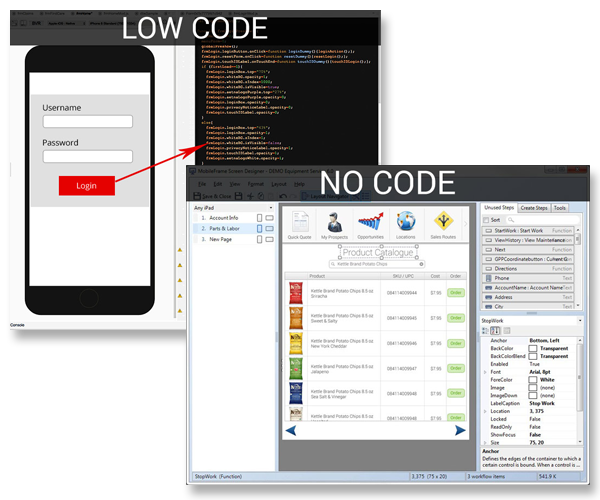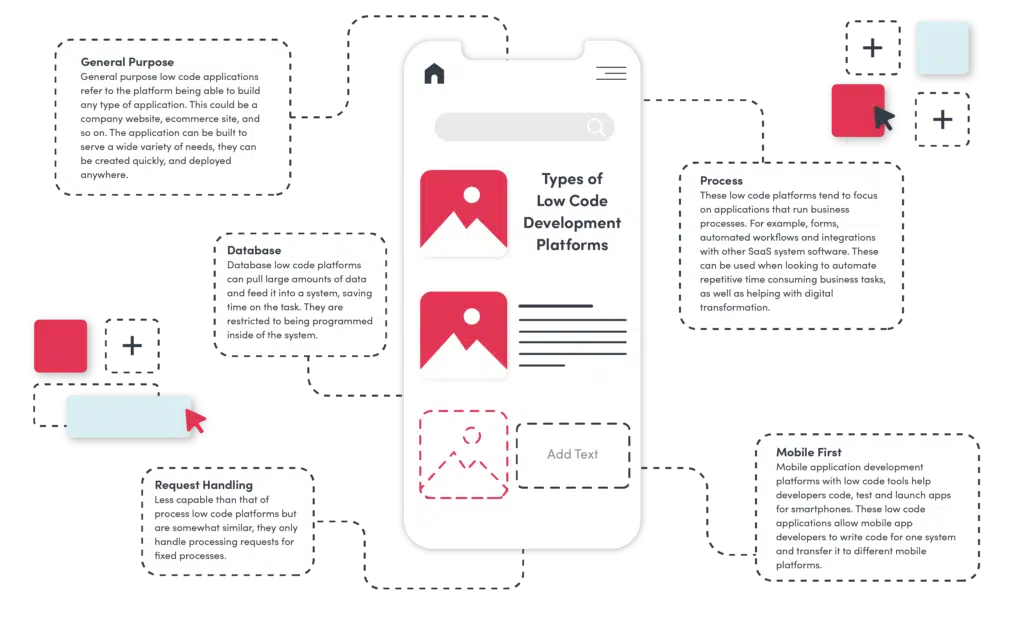Low-code development of apps has numerous benefits, especially in terms integration. This is crucial for creating applications that can seamlessly connect with systems and other services. Here are some of the benefits that come with connectors that are pre-built, APIs, and other tools:
Wide Selection of Connectors. Low-code software typically includes many built-in connections to enterprise systems that are popular (e.g. cloud services, databases, CRM). This allows for easier integration with systems.
API Integration - A lot of low-code platforms have built-in API integration that gives developers easy access to external services or data sources.
Easy To Use
Integrations with Drag-and-Drop Integrations are implemented by using drag and drop interfaces. Developers and non-developers can achieve this without needing to write lengthy code.
Visual Workflow Builders Visual tools to create workflows and data flow aid in understanding and setting up integrations more easily.
Standardized Integration Methods:
SOAP and Restful Service: Supporting standard web service protocols such as SOAP or REST makes it easy to integrate external systems and applications.
OData and other Standards: The support for standards like OData facilitates the access and manipulation data across applications and platforms.
Real-Time Data Synchronization:
Real-Time Integrations: Lowcode platforms handle data synchronization at a real-time rate between applications and system, ensuring data is always up-to-date and consistent across an company.
Event-Driven architecture: Some platforms can support event-driven architectures. This lets applications respond to events in real time and is crucial for interactive and dynamic apps.
Legacy System Integration:
Low-code Platforms: These platforms could be utilized to connect old systems to the latest. They are a great way to modernize your IT infrastructure, without the need to completely overhaul your IT infrastructure.
Data Migration: Built-in tools allow you to transfer data from older applications to new ones that are built on platforms that have low-code.
Integration of Third Party Services:
Integration with Cloud Services: Seamless integration with cloud services like AWS, Azure, and Google Cloud allows for the ease of deployment and scaling applications.
Business Applications Low-code platforms allow you to be integrated with different business apps like Salesforce, SAP or Microsoft Dynamics. They allow an integrated workflow for various business functions.
Simple data management:
Unified Data Models: Some low-code platforms have unification of data models that simplifies data management and integration between different systems.
Data Connectors are data connectors that have been pre-configured which provide quick access to data sources and permit manipulation.
Security and Compliance
Low-code integration platforms comply with security standards to protect data while in transit or in storage.
Security Features: These platform typically have features that assure that integrations are in compliance with regulatory requirements, such as GDPR and HIPAA. This provides peace of mind for businesses that handle sensitive data.
Extensibility:
Low-code platforms are able to accommodate complicated integration requirements by incorporating custom code or scripts. They provide flexibility, but without sacrificing their user-friendliness.
Plug-in Ecosystems. A network of extensions and plug-ins can allow you to enhance your integration capabilities, and add additional functions as needed.
Low-code platforms are a powerful tool to create interconnected, efficient and scalable apps. They make it easier to connecting disparate system, improve data flow and allow enterprises to embrace new technologies while using existing ones. Read the best Low-code Platform for application development for more info including cross platform app development, cross platform app development, app platforms, database in azure, mobile development platforms, application development platforms, mobile app development platforms, developing mobile apps, cross platform app development, stored sql procedures and more.

Low-Code Apps Have Numerous Benefits, Particularly In Terms Of Cost-Effectiveness.
Low-code development can bring many benefits in terms of cost efficiency. This is a great option for businesses that want to maximize their development budgets while providing high-quality applications. Here are a few of the key benefits.
Reduced Coding: Low-code systems minimize the amount of manual coding needed, which in turn reduces the time and energy spent by developers when creating applications. The result is lower labor costs.
We require fewer resources for developers: Programming with low-code is more efficient and quicker, so fewer developers with specialized skills are needed. This could drastically cut costs for hiring and staffing.
Faster time to market:
Accelerated Development Cycle: The visual tools for development and the pre-built components offered by low-code platforms facilitate rapid development of applications, which allows companies to bring their products to the market more quickly. This will result in faster revenues and better position in the marketplace.
Rapid Prototyping: Businesses can develop and test prototypes within a short period of time, which decreases the amount of time needed to develop. This lets them make quicker iterations after receiving user feedback.
Reduced Maintenance Costs
Simpler maintenance: Low-code platforms, with their modular components and standardised components, are easier to maintain. This reduces the ongoing maintenance and support cost.
Automated Patches and Updates: Low-code platforms can manage patching and updating applications in a way that is automatic. This ensures that your application remains secure and always up-to-date without extensive manual intervention.
Efficient Resource Utilization:
Low-code platform contributions let businesses as well as other non-developers to participate in the creation process. This decentralization of development processes allows companies to tap into the expertise and talents of a wider number of employees.
Improved utilization of IT resources IT departments will be able to focus on strategic initiatives rather than being buried in routine tasks of development. This will boost the overall efficiency and productivity.
Scalable Pricing Models
Subscription Pricing: A lot of platforms with low-code offer flexible pricing models based on subscriptions that are scaled in accordance with the amount of usage. This allows businesses to be able to align their spending to the actual requirements and increase their revenue, without incurring large upfront costs.
Pay-As-You-Go Options: Some platforms provide pay-as-you-go options, ensuring that businesses only pay for the services they use and can be especially advantageous for small and start-up companies with a limited budget.
Reduction of Third-Party Costs for Software:
Built-in Functionalities : A low-code platforms often comes with built-in functionality and integrations, which eliminates the requirement for third-party software, tools, and licenses.
Pre-Built Integrations: The existence of pre-built integrations that integrate with the most popular systems and services reduces the requirement for custom-built development, which saves both time and money.
Increased ROI
A faster return on investment: The combination of speedy development, lower cost, and faster time to market means businesses can achieve a faster return on investment (ROI) on their applications.
Enhanced Agility - Businesses can quickly adapt to changes in the market and changing customer needs. This lets them stay current and take advantage of opportunities that arise.
Low-cost Training:
User-Friendly Interfaces: Low-code platforms offer intuitive and easy-to-use interfaces, which decreases the time required to learn.
Accessible Resources: Many platforms using low-code provide an extensive range of training materials, tutorials as well as community support. This eliminates the requirement for formal education as well as the costs associated with it.
Streamlined collaboration:
Enhanced Collaboration Tool The integrated collaboration tool facilitates better communication and cooperation among team members. This leads to more efficient development processes, and decreases the project's overhead.
Unified Development Environment. An unified development platform reduces costs and streamline workflows by simplifying the management of several tools.
In general, low-code apps cost less due to their ability to cut costs of maintenance and development, to accelerate time-to-market, to maximize resource use, and to provide flexible pricing. Low-code offers substantial financial advantages to businesses. Follow the top wavemaker.com coding for site recommendations including developing mobile apps, jdbc server, push alerts, lowcode no code, microsoft azure sql, develop mobile application, low code development platforms, rad development, multiplatform mobile app development, rapid application design and more.

The Advantages Of Low-Code Development For Workflow And Collaboration
Low-code applications offer a number of benefits in workflow and collaboration, which makes it an the ideal option for companies seeking to improve team efficiency and streamlining the development process. Here are the key benefits: Improved Cross-Functional Collaboration:
Unified Development Environment : Low-code platforms provide a unified, one-stop environment in which all team members can collaborate efficiently including designers, business analysts, and stakeholders. This helps to eliminate silos and promotes better communication.
Visual Development Tools: Low-code platforms are easy to use and feature the drag-and-drop interface. This allows non-technical members of the team to participate during the development process and ensures that the business requirements can be gathered precisely.
Communication Enhancement
Real-Time Co-operation: A lot of platforms that have low-code support live-time co-operation capabilities like commenting, editing in parallel and instant feedback. They allow for continuous communication by cutting down on the time needed for back-and-forth discussions.
Shared workspaces: Teams can to work in tandem in shared workspaces where they can edit and discuss the project's elements. This will ensure that everyone is striving for the same objectives and is on the exact same level.
Streamlined Workflow:
Project management tools built-in: Low-code platforms usually come with project management tools integrated that allow teams to plan, track and oversee their projects. This includes the assignment of tasks, progress tracking, deadline management and much more.
Workflow Automation Automating routine tasks or workflows permits teams to concentrate their energy on more strategic initiatives and tasks which improve the efficiency overall of the company.
Faster Iteration:
Rapid Prototyping Low-code platforms are perfect for rapid prototyping. Iterative development is also feasible and allows teams to test, develop and refine their applications in shorter periods. This allows for feedback to be quickly integrated into the application, and for rapid improvement.
Support for Agile Methodologies Using agile methods gives teams to run sprints and continually deliver small amounts of functionality which makes it simpler to adjust to changing requirements.
Accessibility to non-developers
Citizen Development: Low-code platforms offer business users the ability to create and modify apps without coding expertise. This reduces the workload of IT and development teams and lets them respond faster to the needs of business.
Training and Onboarding Simple interfaces and comprehensive training materials make it simpler for new team members to become familiar with the team and improve the overall cohesion within the team.
Centralized Documentation & Knowledge Sharing
Documentation is integrated: Low code platforms often come with the tools needed to create and manage documentation on the platform, allowing to allow all project data to be centralized.
Knowledge Repositories. Teams can set up repositories for knowledge, including templates and parts that can be reused. This will facilitate knowledge sharing, and reduce duplicate work.
Consistency and Standardization
Standardized Components. Standardization of components across different applications assures uniformity, which helps to make it simpler to work with and comprehend by team members.
Governance and Compliance: Integrated in governance frameworks ensure all development adheres to the standards of the organization and regulatory needs, reducing non-compliance risks and ensuring applications meet high quality standards.
Feedback and Improvement Loops:
Integrated Feedback: Low-code platforms provide users with integrated feedback mechanisms which allow them to give users with feedback quickly on their applications. This feedback can be later integrated into the application development process.
Continuous Improvement: The capability to quickly iterate and implement changes based on feedback ensures constant improvement of software, aligning them closely with user needs and business objectives.
Visualization, Reporting and Analysis:
Real-time analytics built-in reporting and analytical features provide real-time insights about the progress of projects, their performance, and user interactions. They facilitate an informed, data-driven decision-making.
Visual Workflow Analysis Visual tools are utilized to map processes and workflows. These tools assist teams analyze and improve their workflows.
Low-code development of applications can be a very effective tool for collaboration and workflow. It connects disparate teams, simplifies communication and automates processes. This encourages a collaborative environment that is agile and efficient in its development process that results in more high-quality apps as well as a better alignment between goals of business.
